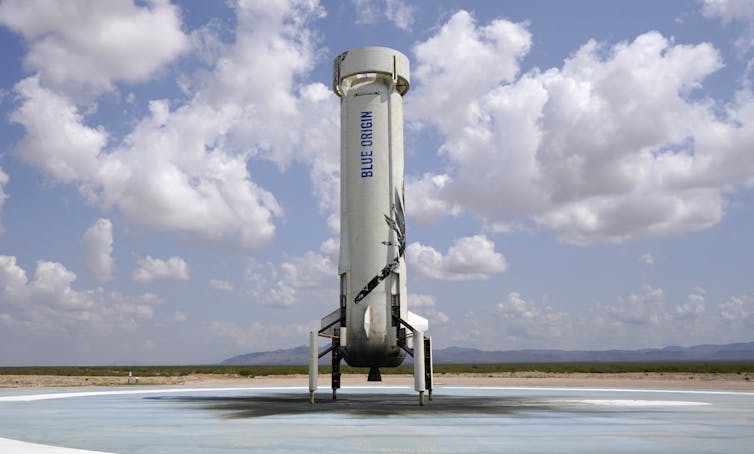
Anadolu/Contributor/Anadolu via Getty Images
Wendy Whitman Cobb, Air University
Just past 2 a.m. Eastern time on Jan. 16, 2025, a new rocket blasted off from the Cape Canaveral Space Force Station in Florida. By reaching orbit, Blue Origin’s New Glenn rocket launch has marked a milestone for a commercial space company that has big ambitions.
As a space policy expert, I see New Glenn’s success as a big leap forward for Blue Origin and a good sign for an expanding, ambitious commercial space industry.
Step by step
Although SpaceX may be the most well-known commercial space company, Blue Origin is older by two years. Founded in 2000 by Amazon’s Jeff Bezos, the company envisions a time when millions of people are living and working in space.
To advance that vision, the company is developing its own line of reusable rockets, which could improve access to space.
Blue Origin’s motto is gradatim ferociter, Latin for “step by step, ferociously.” Bezos has explained that this reflects the company’s approach to spaceflight.
“If you’re building a flying vehicle, you can’t cut any corners. If you do, it’s going to be an illusion that it’s going to make it faster,” Bezos said at the Pathfinder Awards in 2016.
With this step-by-step approach, it took 15 years for Blue Origin to launch its first rocket. New Shepard, which launched in 2015, is named after Alan Shepard, the first American to reach space.
New Shepard is not powerful enough to reach orbit. Instead, it flies a suborbital trajectory. That means it flies to the edge of space, experiencing low gravity for just a few minutes, before returning to its launch site.
What makes New Shepard unique is that it can carry passengers. It did so for the first time on July 20, 2021, when it carried three people, including Bezos, to space. Since then, there have been eight crewed flights of New Shepard and 21 uncrewed flights. Notably, it carried Star Trek’s William Shatner to space on Oct. 13, 2021.

AP Photo/Tony Gutierrez, File
New Shepard has not been without its issues, however. In 2022, it experienced an engine failure a minute after liftoff. With no humans on board, the launch escape system activated, allowing the capsule to safely return to Earth. This landing also meant that had people been on board, they too would have returned safely.
Expanding the envelope
While Blue Origin has learned a lot from New Shepard’s flights, the company needs a more powerful rocket. Named after John Glenn, the first American to reach orbit, New Glenn is designed to be that rocket.
Blue Origin started developing New Glenn in 2013 but only announced it publicly in 2016. It is made up of two sections called stages. The first stage has seven engines. Once this stage has used up all its fuel, the goal is for it to detach and return to a barge at sea, much like SpaceX’s Falcon 9.
At that point, the second stage’s three engines light up, taking the rocket the rest of the way to space.
Unfortunately, on Jan. 16’s maiden launch, the first stage booster was destroyed as it attempted to return to the landing barge. Before the launch, company officials had stated that they weren’t sure they would recover the booster on this flight, but were going to try anyway.
At over 320 feet tall (98 meters), New Glenn is shorter than an Apollo-era Saturn V (363 ft., or 111 m) but taller than both the space shuttle when it was fully stacked (184 ft., or 64 m) and SpaceX’s Falcon 9 (229 ft., or 70 m). It will have double the power of the space shuttle but half the power of the Saturn V.

Jurgenspacerocket/Wikimedia Commons, CC BY-SA
In addition to New Glenn, the company is developing Blue Moon, a lunar lander for use on a future NASA lunar mission. It is also developing Blue Ring, an in-space servicing platform that can refuel and move satellites.
Blue Origin is also a key part of Orbital Reef, a planned commercial space station in low Earth orbit. Blue Origin has likened Orbital Reef to a “mixed-use business park” that will provide space for research, development and manufacturing in orbit.
Implications for commercial space
Blue Origin’s success reaching orbit with New Glenn is an important step for the larger commercial space industry. Importantly, it will create competition for SpaceX, which some argue has a near monopoly on launch services in the United States.
Competition for launch services is a valuable thing. It provides incentive for both companies to deliver the best service at the lowest cost. Having multiple launch providers is also a sign of a healthy commercial market.
Competition also provides options for accessing space in case one company must ground its fleet of rockets. This happened several times to SpaceX in 2024 when three of its rockets experienced problems during launch. The situation left no option for customers except to wait until SpaceX investigated and fixed the issues.
While New Glenn will be launching uncrewed missions for the next few years, Blue Origin signed a Space Act Agreement with NASA in 2023 to develop more commercial projects, including a crew vehicle.
A Blue Origin crew vehicle would provide NASA with more options when transporting humans to and from low-Earth orbit or even the Moon.
Though this launch of New Glenn has been 25 years in the making, for Blue Origin it is a major accomplishment – and a necessary one if it wants to “ferociously” continue its goals for space travel.
Wendy Whitman Cobb, Professor of Strategy and Security Studies, Air University
This article is republished from The Conversation under a Creative Commons license. Read the original article.
































































